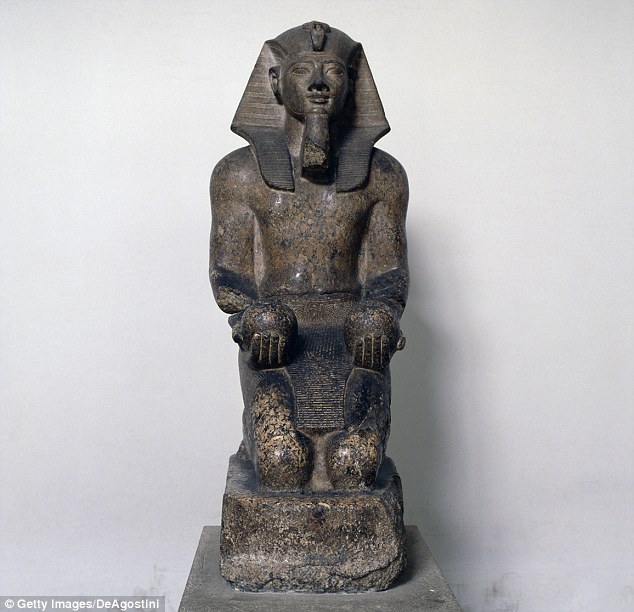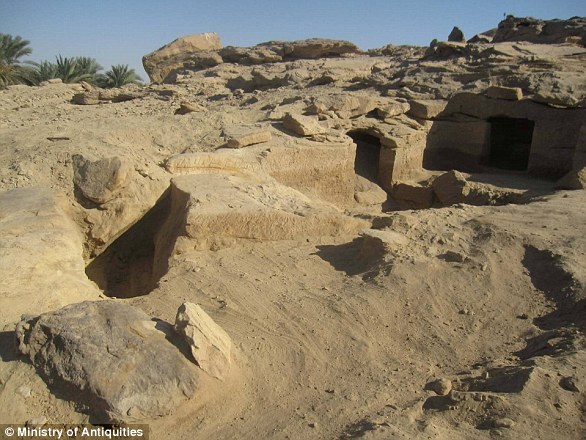It was discovered in the 1850s, but details on this rare ancient Egyptian treasure have remained a mystery to experts.
Now, the 3,400-year-old fragmented wooden box has been pieced together by a museum in Scotland.
Experts believe the treasure has royal associations to Pharaoh Amenhotep II - something which had long been guessed at but never before confirmed. ..
Egyptian treasure riddle cracked after 160 years: Missing fragments reveal 3,400-year-old wooden box is linked to Pharaoh Amenhotep II
National Museums Scotland acquired the wooden box in the 1850s
But it was in a fragmentary state with a portion of it missing
Museum bosses have found the two missing pieces on the art market
By Shivali Best For Mailonline
11 January 2017
It was discovered in the 1850s, but details on this rare ancient Egyptian treasure have remained a mystery to experts.
Now, the 3,400-year-old fragmented wooden box has been pieced together by a museum in Scotland.
Experts believe the treasure has royal associations to Pharaoh Amenhotep II - something which had long been guessed at but never before confirmed.

It was discovered in the 1850s, but details on this rare ancient Egyptian treasure have remained a mystery to experts. But the 3,400-year-old fragmented wooden box has now been pieced together by a museum in Scotland
National Museums Scotland (NMS) acquired the wooden box in the 1850s, but it was in a fragmentary state with a portion of it missing.
Museum bosses have now obtained two of the missing pieces after they appeared on the art market.
Significantly, the rare fragments feature a royal motif, allowing experts to be certain of the treasure's royal associations.
They also reveal that part of the box was incorrectly restored in the mid-20th century.
Dr Margaret Maitland, senior curator of the ancient Mediterranean collection at NMS, said: 'We are delighted to have the opportunity to reunite these fragments with our spectacular box, which is one of the great treasures from our ancient Egyptian collections.
'Palace objects from ancient Egypt are extremely rare, so it's very exciting for us to be able to confirm this object's royal connections.
'Not only does the acquisition of the fragments fill a literal gap in the box, it fills gaps in our understanding of its story.'

The box - made from cedar, ebony, ivory and gold - was made during the reign of Pharaoh Amenhotep II, who ruled ancient Egypt during the 18th dynasty, around 1427-1400 BC
The box - made from cedar, ebony, ivory and gold - was made during the reign of Pharaoh Amenhotep II, who ruled ancient Egypt during the 18th dynasty, around 1427-1397 BC.
The materials came from different areas of the ancient Mediterranean, signifying the extent of the king's empire and its wealth.
Experts describe the box as one of the finest examples of decorative woodwork to survive from ancient Egypt.

Pharaoh Amenhotep II was the seventh Pharaoh of the 18th dynasty of Egypt. Pictured is a statued depicting him
They believe the item, an elaborate version of the types of wooden containers often found in ancient Egyptian tombs, was probably used in the royal palace to hold cosmetics or expensive perfumes and likely belonged to a member of the king's family.
Evidence suggests the box was originally excavated in a tomb belonging to a group of 10 princesses, including daughters of Pharaoh Thutmose IV, the son of Pharaoh Amenhotep II.
The fragments were acquired with support from the Art Fund and the NMS charitable trust.

The item, an elaborate version of the types of wooden containers often found in ancient Egyptian tombs, was probably used in the royal palace to hold cosmetics or expensive perfumes and likely belonged to a member of the king's family
Art Fund director Stephen Deuchar said: 'We are really happy to have helped National Museums Scotland take this unique opportunity to reunite the two fragments with their larger whole - one of the most significant objects in their ancient Egyptian collections.'
The box and fragments will go on display in a new exhibition, The Tomb: Ancient Egyptian Burial, which opens at the National Museum of Scotland on March 31.
They will then go on permanent display in a new ancient Egypt gallery at the museum, opening in 2018/19.
PHARAOH AMENHOTEP II

Pharaoh Amenhotep II inherited an empire that stretched from the Euphrates to Sudan.
The 18th dynasty ruler became king aged around 18.
He is believed to have ruled Egypt between 1427 to 1397 BC.
After becoming pharaoh, Amenhotep married a woman of uncertain parentage named Tiaa. As many as ten sons and one daughter have been attributed to him.
The king's palace at Malkata was close to his funerary temple - the largest ever built with its original location marked by the two 'Colossi of Memnon' statues.
12 NEW BURIAL SITES FOUND
Swedish archaeologists have unearthed a dozen new burial sites dating back 3,500 years near the southern Egyptian city of Aswan.
The new sites were found at the Gebel el-Silsila, a necropolis that was first discovered in 2015, and are believed to be from the New Kingdom era.
While experts initially believed the tombs may have been the final resting place of high status individuals, their identity remains a mystery.
Human and animal remains were found in the cemeteries, which were discovered in the Gebel el-Silsila or Chain of Mountains area 40 miles north of Aswan.
It is thought the cemeteries would have been used during the reigns of pharaohs Thutmose III and Amenhotep II.

Some of the cemeteries were for animals and contain one or two chambers with either stone or clay coffins, or ones made of cartonnage, Mahmoud Afify, the ministry's head of Ancient Egyptian Antiquities, said in a statement
Read more: Egyptian treasure riddle cracked after 160 years | Daily Mail Online
Follow us: @MailOnline on Twitter | DailyMail on Facebook
Now, the 3,400-year-old fragmented wooden box has been pieced together by a museum in Scotland.
Experts believe the treasure has royal associations to Pharaoh Amenhotep II - something which had long been guessed at but never before confirmed. ..
Egyptian treasure riddle cracked after 160 years: Missing fragments reveal 3,400-year-old wooden box is linked to Pharaoh Amenhotep II
National Museums Scotland acquired the wooden box in the 1850s
But it was in a fragmentary state with a portion of it missing
Museum bosses have found the two missing pieces on the art market
By Shivali Best For Mailonline
11 January 2017
It was discovered in the 1850s, but details on this rare ancient Egyptian treasure have remained a mystery to experts.
Now, the 3,400-year-old fragmented wooden box has been pieced together by a museum in Scotland.
Experts believe the treasure has royal associations to Pharaoh Amenhotep II - something which had long been guessed at but never before confirmed.

It was discovered in the 1850s, but details on this rare ancient Egyptian treasure have remained a mystery to experts. But the 3,400-year-old fragmented wooden box has now been pieced together by a museum in Scotland
National Museums Scotland (NMS) acquired the wooden box in the 1850s, but it was in a fragmentary state with a portion of it missing.
Museum bosses have now obtained two of the missing pieces after they appeared on the art market.
Significantly, the rare fragments feature a royal motif, allowing experts to be certain of the treasure's royal associations.
They also reveal that part of the box was incorrectly restored in the mid-20th century.
Dr Margaret Maitland, senior curator of the ancient Mediterranean collection at NMS, said: 'We are delighted to have the opportunity to reunite these fragments with our spectacular box, which is one of the great treasures from our ancient Egyptian collections.
'Palace objects from ancient Egypt are extremely rare, so it's very exciting for us to be able to confirm this object's royal connections.
'Not only does the acquisition of the fragments fill a literal gap in the box, it fills gaps in our understanding of its story.'

The box - made from cedar, ebony, ivory and gold - was made during the reign of Pharaoh Amenhotep II, who ruled ancient Egypt during the 18th dynasty, around 1427-1400 BC
The box - made from cedar, ebony, ivory and gold - was made during the reign of Pharaoh Amenhotep II, who ruled ancient Egypt during the 18th dynasty, around 1427-1397 BC.
The materials came from different areas of the ancient Mediterranean, signifying the extent of the king's empire and its wealth.
Experts describe the box as one of the finest examples of decorative woodwork to survive from ancient Egypt.

Pharaoh Amenhotep II was the seventh Pharaoh of the 18th dynasty of Egypt. Pictured is a statued depicting him
They believe the item, an elaborate version of the types of wooden containers often found in ancient Egyptian tombs, was probably used in the royal palace to hold cosmetics or expensive perfumes and likely belonged to a member of the king's family.
Evidence suggests the box was originally excavated in a tomb belonging to a group of 10 princesses, including daughters of Pharaoh Thutmose IV, the son of Pharaoh Amenhotep II.
The fragments were acquired with support from the Art Fund and the NMS charitable trust.

The item, an elaborate version of the types of wooden containers often found in ancient Egyptian tombs, was probably used in the royal palace to hold cosmetics or expensive perfumes and likely belonged to a member of the king's family
Art Fund director Stephen Deuchar said: 'We are really happy to have helped National Museums Scotland take this unique opportunity to reunite the two fragments with their larger whole - one of the most significant objects in their ancient Egyptian collections.'
The box and fragments will go on display in a new exhibition, The Tomb: Ancient Egyptian Burial, which opens at the National Museum of Scotland on March 31.
They will then go on permanent display in a new ancient Egypt gallery at the museum, opening in 2018/19.
PHARAOH AMENHOTEP II

Pharaoh Amenhotep II inherited an empire that stretched from the Euphrates to Sudan.
The 18th dynasty ruler became king aged around 18.
He is believed to have ruled Egypt between 1427 to 1397 BC.
After becoming pharaoh, Amenhotep married a woman of uncertain parentage named Tiaa. As many as ten sons and one daughter have been attributed to him.
The king's palace at Malkata was close to his funerary temple - the largest ever built with its original location marked by the two 'Colossi of Memnon' statues.
12 NEW BURIAL SITES FOUND
Swedish archaeologists have unearthed a dozen new burial sites dating back 3,500 years near the southern Egyptian city of Aswan.
The new sites were found at the Gebel el-Silsila, a necropolis that was first discovered in 2015, and are believed to be from the New Kingdom era.
While experts initially believed the tombs may have been the final resting place of high status individuals, their identity remains a mystery.
Human and animal remains were found in the cemeteries, which were discovered in the Gebel el-Silsila or Chain of Mountains area 40 miles north of Aswan.
It is thought the cemeteries would have been used during the reigns of pharaohs Thutmose III and Amenhotep II.

Some of the cemeteries were for animals and contain one or two chambers with either stone or clay coffins, or ones made of cartonnage, Mahmoud Afify, the ministry's head of Ancient Egyptian Antiquities, said in a statement
Read more: Egyptian treasure riddle cracked after 160 years | Daily Mail Online
Follow us: @MailOnline on Twitter | DailyMail on Facebook
Last edited: